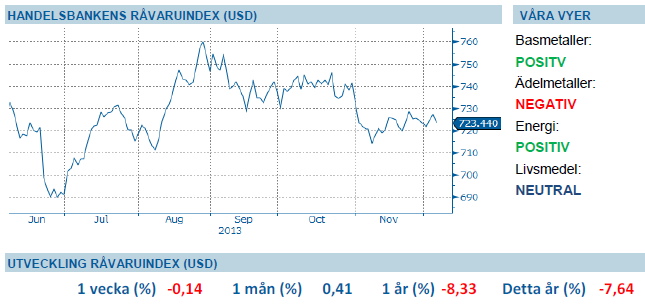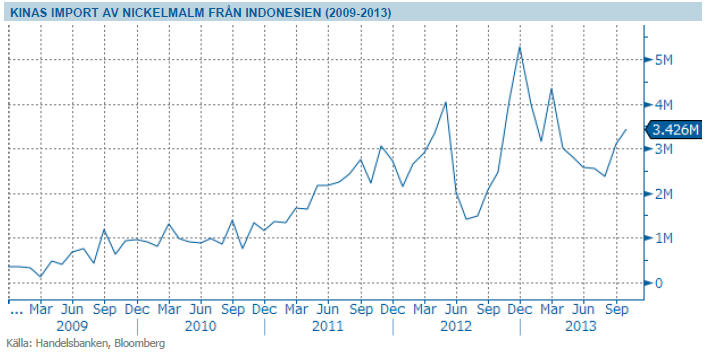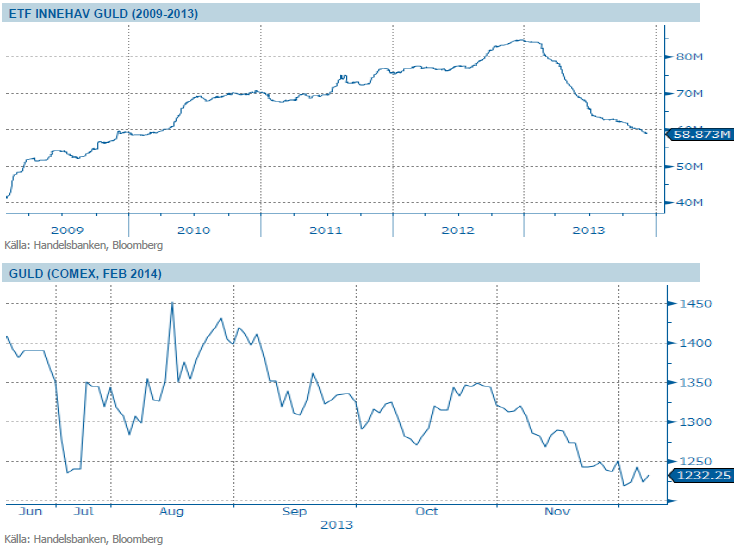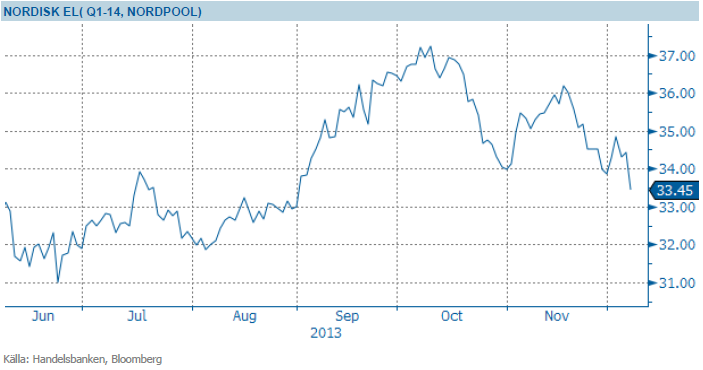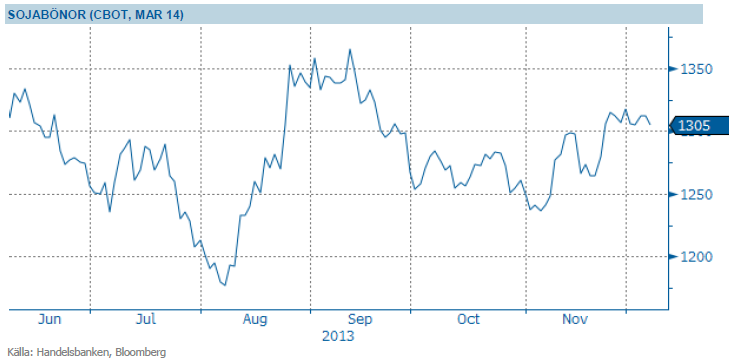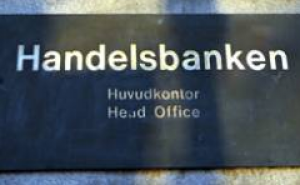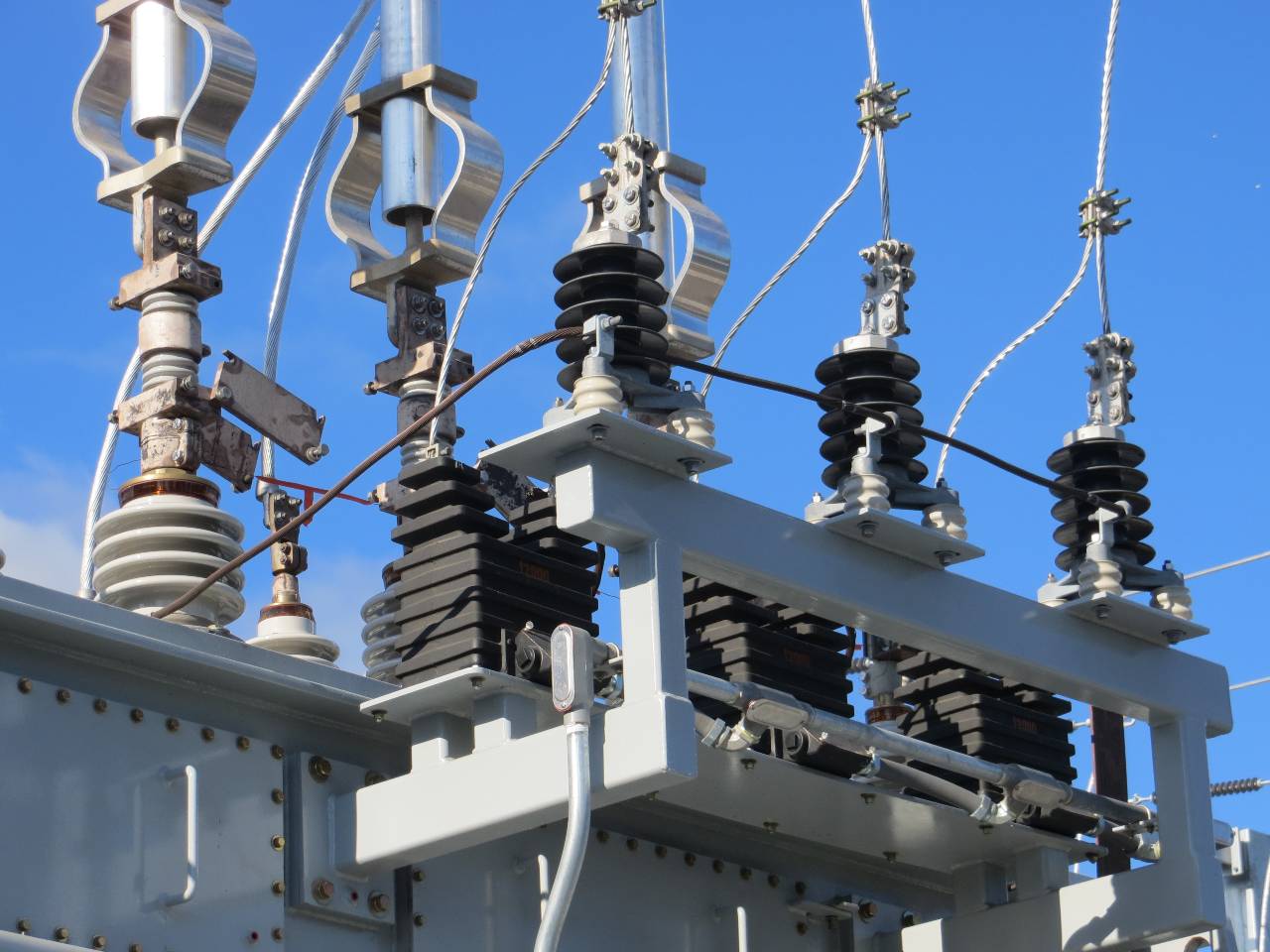Analys
SHB Råvarubrevet 6 december 2013
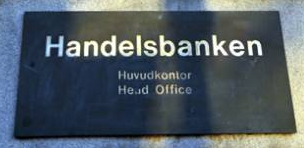
 Råvaror allmänt
Råvaror allmänt
Råvaror gynnas av makroklimatet
För råvaror är det generella makroklimatet gott. Vi ser ett starkt momentum i Kina, centralbanker världen över fortsätter vara superrelaxade och den generella konjunkturåterhämtningen fortsätter varför 2014 kommer bli ett bättre år för världsekonomin än 2013. Trots detta ser vi ingen stark trend uppåt bland råvarorna. Investerare har blivit mer försiktiga när man diskonterar Kinas lägre tillväxt framgent. Den tillväxt som finns blir också allt mindre tiltad mot infrastrukturella investeringar. I det korta perspektivet ser vi att lagercykeln bottnar ur och ska efterföljas av en påfyllnad med ökad import av råvaror som konsekvens.
I närtid finns mer ljus. Oljemarknaden har ett säsongsmässigt starkt kvartal framför sig drivet av bland annat norra halvklotets vinter. Vi har listat utsikterna för guld och silver och det enda argumentet för uppgång i närtid är skuldtaksdiskussionen i USA i januari. Tyngst vägande på nedsidan ser vi den stundande nedskalningen av QE vara. Den amerikanska konjunkturen fortsätter att förbättras och med det tilltar Taper-oron. Framför allt starkare arbetsmarknadsdata ökar sannolikheten för att Fed rör sig i närtid.
Positiv data fortsätter under fredagseftermiddag. USA:s non-farm payrolls visade på fler sysselsatta än väntat. 203 000 fler i november mot förväntat 185 000.
Basmetaller
Indonesiens exportförbud åter i fokus
Priset på samtliga basmetaller har stigit under veckan, vårt basmetallindex är stiger med 1,1 %. Stark jobbdata från USA har stärkt metallerna men även Indonesiens exportförbud har stått i fokus och givit stöd. Potentialen för nickel under 2014 är till del beroende av Indonesiens planerade exportförbud. För den som inte är insatt i problematiken har Kina under senare år kraftigt ökat sin import av lågkvalitativ nickelmalm från främst Indonesien. Kina utvinner sedan själva nickeln ur malmen, med stora negativa miljöeffekter. Detta har gjort att priset på nickel fallit kraftigt på världsmarknaden. Indonesien vill nu få en större del av förädlingsvärdet själva och har därför beslutat om ett exportförbud på nickelmalm från och med årsskiftet 2013/14.
Detta har gjort att Kina importerat ännu mer nickelmalm i år för att lägga på lager, och importerat mindre nickel. Nickelpriset har även påverkats negativt av den svaga ekonomiska utvecklingen i Europa och av den pågående diskussionen om att Kina ställer om från investerings- till konsumtionsledd tillväxt. Om Indonesiens exportstopp träder i kraft som planerat, kommer Kinas lager av nickelmalm successivt att betas av och därefter bedömer vi att priserna på nickel kommer att börja stiga igen, eftersom Kina måste börja importera. Den exakta tidpunkten för detta är dock svår att fastslå. Dessutom finns en risk att Indonesien i sista stund ställer in exportförbudet, på grund av politiska påtryckningar. Sannolikheten för detta är ännu svårare att bestämma. Vår grundsyn är dock att nickelpriset bör återhämta sig under loppet av 2014, om världskonjunkturen fortsätter att förbättras och Indonesien inför exportförbud.
Exportförbudet ger även stöd till aluminium och kopparpriset då bauxit och kopparmalm även innefattas av förbudet.
Vi tror att Kinas tillväxt kommer överraska positivt under Q4 och Q1, vilket kommer stärka metallerna. Vi tror på: LONG BASMETALLER H
Ädelmetaller
Guldet fortsätter sin väg nedför
Guldet har visserligen haft en del rörelser under veckan men stänger veckan på minus återigen. Och utflödet ur guld ETF:er fortsätter. Vi hade under förra veckan hela nordens gruv- och metallindustrihöjdare i Stockholm, och har kunnat lyssna in på deras syn på marknaden för 2014. Det som stack ut när det gäller guld är att just denna metall toppat investerares intresse att placera gruvrelaterat riskkapital under 2012. Vår syn är att denna sorts investeringar görs både med eftersläpning och i flockbeteende. 2013 års prisfall på guld gör att vår gissning är att guldet inte kommer toppa tabellerna när årets investeringar summeras. Detta torde tala för ett minskat utbud av nyproducerat fysiskt guld framöver, vilket teoretiskt torde peka på att priset kan bottna ur.
Men som vi skrivit om tidigare, världen kommer inte att drabbas av plötslig guldbrist, allt guld som utvunnits i historien finns fortfarande kvar i lager. Lager för guld är ju bankvalv, bankfack eller smyckeskrin. Efter våra kontakter i veckan blev det också tydligt att branschen inte är inställd på att priset ska kunna komma ner till tresiffriga nivåer. Då hela vår erfarenhet från andra marknader lärt oss att just marknader tenderar att vara riktigt elaka tror vi att 1000 dollar per uns kommer att testas.
Efter en uppgång under sommaren tror vi åter att guldets väg lutar utför. Vi tror på: SHRT GULD H
Energi
OPEC möte i fokus
Brent noteras närmare 2 månaders högsta efter positiv statistik från de två ledande oljekonsumenterna USA och Kina. Intressant att även notera investerarstatistiken där nettolånga positioner på Brent ökat med 43 procent de senaste två veckorna. Fokus har under veckan annars varit på OPEC mötet i Wien där Saudi´s oljeminister signalerade att ”the oil market is in the best situation it can be and that the current price level is the right price”. Det går att tolka som att OPEC sannolikt inte kommer att göra så mycket mer just nu men men sannolikt kommer att agera i takt med att Libyen´s samt övriga löser sina utbudsstörningar. Brent och WTI spreaden krymper efter nyheten om att TransCanada´s pipeline (700,000bpd) ser ut att komma igång vilket kommer att minska lagren vid Cushing. Läs även veckans tradingcase på olja här.
Elmarknaden som öppnade upp under inledningen av veckan försvagas mot slutet (Q1-14 når nytt all time low) och det är främst väderprognoserna som tynger sentimentet. Ett vått (ca 3TWh nederbörd över normalt) och milt (1-2 grader över normalt) scenario för hela den kommande 10-dagars perioden innebär att energiunderskottet fortsätter at minska i rask takt mot normalnivåer om det här håller i sig.
Inga större förändringar på vare sig kol som finner stöd strax över 80 USD/ton eller utsläppsrätter vilket med USD/EUR utvecklingen innebär att brytpriset ligger kvar oförändrat den senaste månaden. Med prognosen som ligger bör kvartalskontrakten kunna falla ytterligare någon EUR men vi bedömer att fallhöjden sedan är begränsad om vi går mot normalväder igen.
Konjunkturen för 2014 ser ut att bli starkare än 2013 för samtliga regioner i världen, och konsumtionen av olja minskar inte trots ett starkt driv mot förnyelsebara energikällor. Vi tror på: LONG OLJA H
Livsmedel
Höga sojaskördar väntas i Sydamerika
Priset på sojabönor faller med någon procent under veckan i linje med våra förväntningar. Mest i fokus nu är väderutvecklingen i Sydamerika, vilken än så länge varit gynnsam. Den brasilianska sådden går mot sitt slut och gynnsamt regn har fallit. I Argentina uppges 58 procent av sådden vara avklarad. Om inga väderproblem uppstår i Sydamerika tror vi på lägre priser framöver – just för tillfället får dock priserna stöd av en ganska god efterfrågan, som vanligt inte minst från Kina.
Majs har handlats upp nästan 2 % under veckan. Mer regn har fallit i de norra delarna av Argentina, vilket är klart gynnsamt för redan sådd gröda och gynnar även pågående sådd. I landets södra delar önskas fortfarande dock mer regn. 48 % av sådden uppges vara avklarad, att jämföra med 58% vid samma tid förra året. Sista delen av skörden i EU går så sakteliga framåt i stundtals regn stundtals snö, dock återstår nu endast en liten del. Liknande situation råder i Ukraina. Utan mer väderproblem i Sydamerika är det för tillfället svårt att se varför majspriserna skulle börja stiga då tillgången på majs globalt är väldigt god.
Efter flera år av rekordskördar handlas kaffe idag på femårslägsta. Vi finner kaffe köpvärd och ser risken på nedsidan begränsad. Vi tror på: LONG KAFFE H
Handelsbankens Råvaruindex
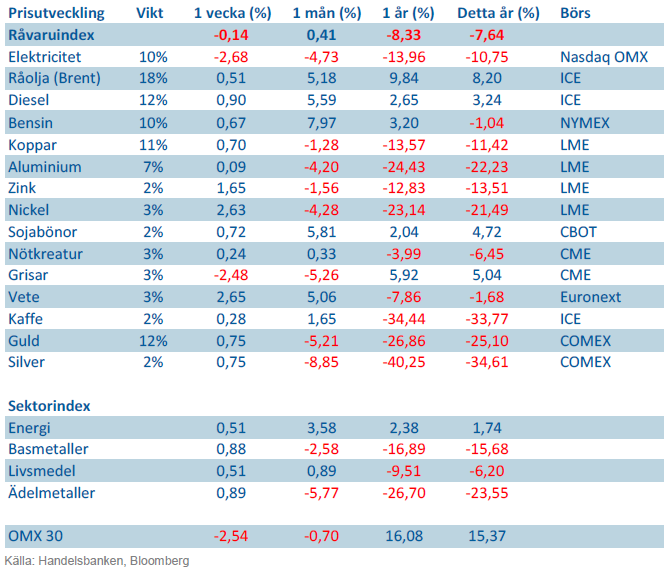
*Nya vikter från den 29 november 2013.
Handelsbankens råvaruindex består av de underliggande indexen för respektive råvara. Vikterna är bestämda till hälften från värdet av nordisk produktion (globala produktionen för sektorindex) och till hälften från likviditeten i terminskontrakten.
[box]SHB Råvarubrevet är producerat av Handelsbanken och publiceras i samarbete och med tillstånd på Råvarumarknaden.se[/box]
Ansvarsbegränsning
Detta material är producerat av Svenska Handelsbanken AB (publ) i fortsättningen kallad Handelsbanken. De som arbetar med innehållet är inte analytiker och materialet är inte oberoende investeringsanalys. Innehållet är uteslutande avsett för kunder i Sverige. Syftet är att ge en allmän information till Handelsbankens kunder och utgör inte ett personligt investeringsråd eller en personlig rekommendation. Informationen ska inte ensamt utgöra underlag för investeringsbeslut. Kunder bör inhämta råd från sina rådgivare och basera sina investeringsbeslut utifrån egen erfarenhet.
Informationen i materialet kan ändras och också avvika från de åsikter som uttrycks i oberoende investeringsanalyser från Handelsbanken. Informationen grundar sig på allmänt tillgänglig information och är hämtad från källor som bedöms som tillförlitliga, men riktigheten kan inte garanteras och informationen kan vara ofullständig eller nedkortad. Ingen del av förslaget får reproduceras eller distribueras till någon annan person utan att Handelsbanken dessförinnan lämnat sitt skriftliga medgivande. Handelsbanken ansvarar inte för att materialet används på ett sätt som strider mot förbudet mot vidarebefordran eller offentliggörs i strid med bankens regler.
Analys
Brent crude ticks higher on tension, but market structure stays soft
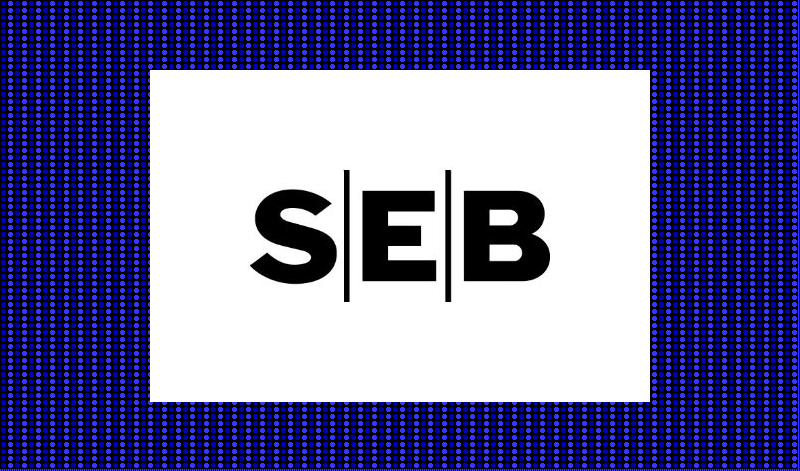
Brent crude has climbed roughly USD 1.5-2 per barrel since Friday, yet falling USD 0.3 per barrel this mornig and currently trading near USD 67.25/bbl after yesterday’s climb. While the rally reflects short-term geopolitical tension, price action has been choppy, and crude remains locked in a broader range – caught between supply-side pressure and spot resilience.

Prices have been supported by renewed Ukrainian drone strikes targeting Russian infrastructure. Over the weekend, falling debris triggered a fire at the 20mtpa Kirishi refinery, following last week’s attack on the key Primorsk terminal.
Argus estimates that these attacks have halted ish 300 kbl/d of Russian refining capacity in August and September. While the market impact is limited for now, the action signals Kyiv’s growing willingness to disrupt oil flows – supporting a soft geopolitical floor under prices.
The political environment is shifting: the EU is reportedly considering sanctions on Indian and Chinese firms facilitating Russian crude flows, while the U.S. has so far held back – despite Bessent warning that any action from Washington depends on broader European participation. Senator Graham has also publicly criticized NATO members like Slovakia and Hungary for continuing Russian oil imports.
It’s worth noting that China and India remain the two largest buyers of Russian barrels since the invasion of Ukraine. While New Delhi has been hit with 50% secondary tariffs, Beijing has been spared so far.
Still, the broader supply/demand balance leans bearish. Futures markets reflect this: Brent’s prompt spread (gauge of near-term tightness) has narrowed to the current USD 0.42/bl, down from USD 0.96/bl two months ago, pointing to weakening backwardation.
This aligns with expectations for a record surplus in 2026, largely driven by the faster-than-anticipated return of OPEC+ barrels to market. OPEC+ is gathering in Vienna this week to begin revising member production capacity estimates – setting the stage for new output baselines from 2027. The group aims to agree on how to define “maximum sustainable capacity,” with a proposal expected by year-end.
While the IEA pegs OPEC+ capacity at 47.9 million barrels per day, actual output in August was only 42.4 million barrels per day. Disagreements over data and quota fairness (especially from Iraq and Nigeria) have already delayed this process. Angola even quit the group last year after being assigned a lower target than expected. It also remains unclear whether Russia and Iraq can regain earlier output levels due to infrastructure constraints.
Also, macro remains another key driver this week. A 25bp Fed rate cut is widely expected tomorrow (Wednesday), and commodities in general could benefit a potential cut.
Summing up: Brent crude continues to drift sideways, finding near-term support from geopolitics and refining strength. But with surplus building and market structure softening, the upside may remain capped.
Analys
Volatile but going nowhere. Brent crude circles USD 66 as market weighs surplus vs risk

Brent crude is essentially flat on the week, but after a volatile ride. Prices started Monday near USD 65.5/bl, climbed steadily to a mid-week high of USD 67.8/bl on Wednesday evening, before falling sharply – losing about USD 2/bl during Thursday’s session.

Brent is currently trading around USD 65.8/bl, right back where it began. The volatility reflects the market’s ongoing struggle to balance growing surplus risks against persistent geopolitical uncertainty and resilient refined product margins. Thursday’s slide snapped a three-day rally and came largely in response to a string of bearish signals, most notably from the IEA’s updated short-term outlook.
The IEA now projects record global oversupply in 2026, reinforcing concerns flagged earlier by the U.S. EIA, which already sees inventories building this quarter. The forecast comes just days after OPEC+ confirmed it will continue returning idle barrels to the market in October – albeit at a slower pace of +137,000 bl/d. While modest, the move underscores a steady push to reclaim market share and adds to supply-side pressure into year-end.
Thursday’s price drop also followed geopolitical incidences: Israeli airstrikes reportedly targeted Hamas leadership in Doha, while Russian drones crossed into Polish airspace – events that initially sent crude higher as traders covered short positions.
Yet, sentiment remains broadly cautious. Strong refining margins and low inventories at key pricing hubs like Europe continue to support the downside. Chinese stockpiling of discounted Russian barrels and tightness in refined product markets – especially diesel – are also lending support.
On the demand side, the IEA revised up its 2025 global demand growth forecast by 60,000 bl/d to 740,000 bl/d YoY, while leaving 2026 unchanged at 698,000 bl/d. Interestingly, the agency also signaled that its next long-term report could show global oil demand rising through 2050.
Meanwhile, OPEC offered a contrasting view in its latest Monthly Oil Market Report, maintaining expectations for a supply deficit both this year and next, even as its members raise output. The group kept its demand growth estimates for 2025 and 2026 unchanged at 1.29 million bl/d and 1.38 million bl/d, respectively.
We continue to watch whether the bearish supply outlook will outweigh geopolitical risk, and if Brent can continue to find support above USD 65/bl – a level increasingly seen as a soft floor for OPEC+ policy.
Analys
Waiting for the surplus while we worry about Israel and Qatar

Brent crude makes some gains as Israel’s attack on Hamas in Qatar rattles markets. Brent crude spiked to a high of USD 67.38/b yesterday as Israel made a strike on Hamas in Qatar. But it wasn’t able to hold on to that level and only closed up 0.6% in the end at USD 66.39/b. This morning it is starting on the up with a gain of 0.9% at USD 67/b. Still rattled by Israel’s attack on Hamas in Qatar yesterday. Brent is getting some help on the margin this morning with Asian equities higher and copper gaining half a percent. But the dark cloud of surplus ahead is nonetheless hanging over the market with Brent trading two dollar lower than last Tuesday.

Geopolitical risk premiums in oil rarely lasts long unless actual supply disruption kicks in. While Israel’s attack on Hamas in Qatar is shocking, the geopolitical risk lifting crude oil yesterday and this morning is unlikely to last very long as such geopolitical risk premiums usually do not last long unless real disruption kicks in.
US API data yesterday indicated a US crude and product stock build last week of 3.1 mb. The US API last evening released partial US oil inventory data indicating that US crude stocks rose 1.3 mb and middle distillates rose 1.5 mb while gasoline rose 0.3 mb. In total a bit more than 3 mb increase. US crude and product stocks usually rise around 1 mb per week this time of year. So US commercial crude and product stock rose 2 mb over the past week adjusted for the seasonal norm. Official and complete data are due today at 16:30.
A 2 mb/week seasonally adj. US stock build implies a 1 – 1.4 mb/d global surplus if it is persistent. Assume that if the global oil market is running a surplus then some 20% to 30% of that surplus ends up in US commercial inventories. A 2 mb seasonally adjusted inventory build equals 286 kb/d. Divide by 0.2 to 0.3 and we get an implied global surplus of 950 kb/d to 1430 kb/d. A 2 mb/week seasonally adjusted build in US oil inventories is close to noise unless it is a persistent pattern every week.
US IEA STEO oil report: Robust surplus ahead and Brent averaging USD 51/b in 2026. The US EIA yesterday released its monthly STEO oil report. It projected a large and persistent surplus ahead. It estimates a global surplus of 2.2 m/d from September to December this year. A 2.4 mb/d surplus in Q1-26 and an average surplus for 2026 of 1.6 mb/d resulting in an average Brent crude oil price of USD 51/b next year. And that includes an assumption where OPEC crude oil production only averages 27.8 mb/d in 2026 versus 27.0 mb/d in 2024 and 28.6 mb/d in August.
Brent will feel the bear-pressure once US/OECD stocks starts visible build. In the meanwhile the oil market sits waiting for this projected surplus to materialize in US and OECD inventories. Once they visibly starts to build on a consistent basis, then Brent crude will likely quickly lose altitude. And unless some unforeseen supply disruption kicks in, it is bound to happen.
US IEA STEO September report. In total not much different than it was in January
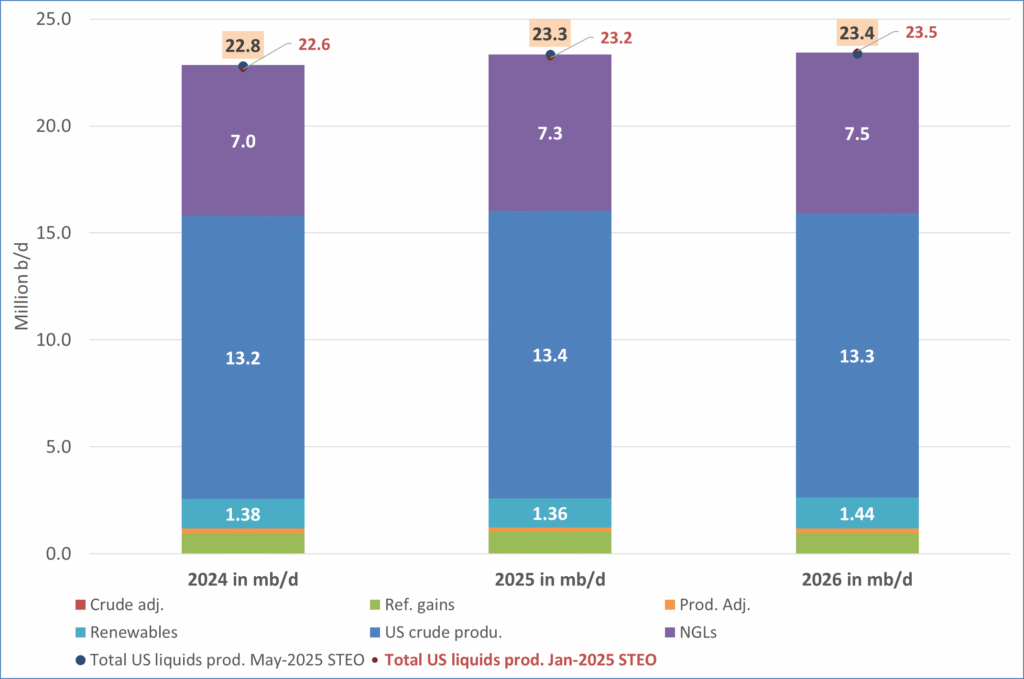
US IEA STEO September report. US crude oil production contracting in 2026, but NGLs still growing. Close to zero net liquids growth in total.
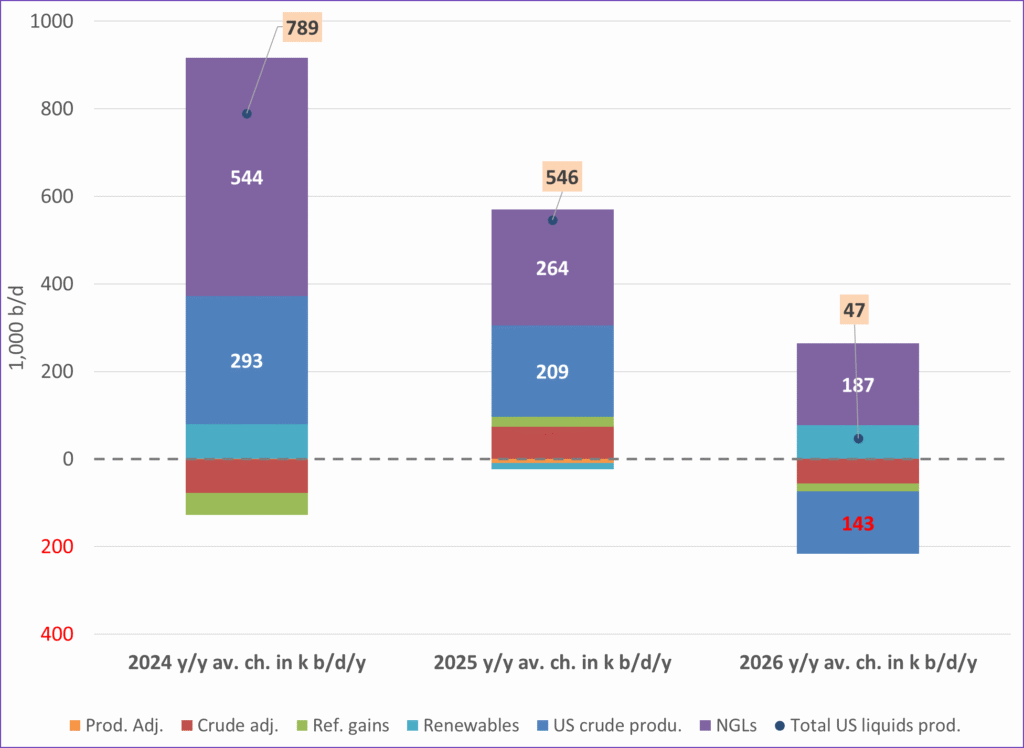
-

 Nyheter4 veckor sedan
Nyheter4 veckor sedanMeta bygger ett AI-datacenter på 5 GW och 2,25 GW gaskraftverk
-
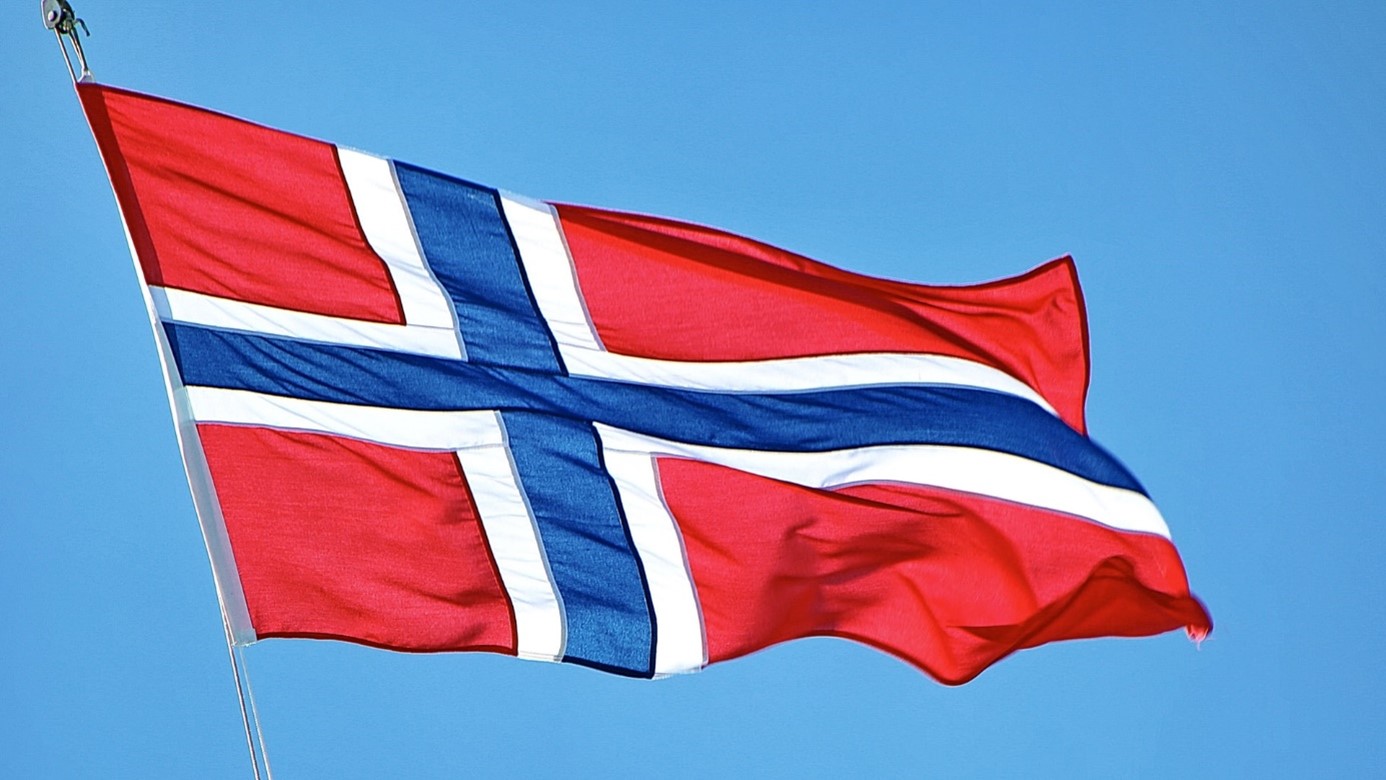
 Nyheter4 veckor sedan
Nyheter4 veckor sedanAker BP gör ett av Norges största oljefynd på ett decennium, stärker resurserna i Yggdrasilområdet
-

 Nyheter4 veckor sedan
Nyheter4 veckor sedanEtt samtal om koppar, kaffe och spannmål
-

 Analys4 veckor sedan
Analys4 veckor sedanBrent sideways on sanctions and peace talks
-

 Nyheter4 veckor sedan
Nyheter4 veckor sedanSommarens torka kan ge högre elpriser i höst
-

 Analys4 veckor sedan
Analys4 veckor sedanBrent edges higher as India–Russia oil trade draws U.S. ire and Powell takes the stage at Jackson Hole
-
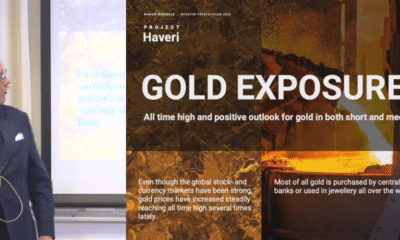
 Nyheter3 veckor sedan
Nyheter3 veckor sedanMahvie Minerals är verksamt i guldrikt område i Finland
-

 Analys3 veckor sedan
Analys3 veckor sedanIncreasing risk that OPEC+ will unwind the last 1.65 mb/d of cuts when they meet on 7 September


